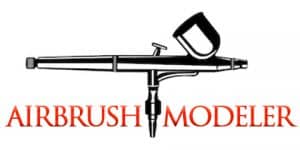What Is A Gravity Feed Airbrush
A gravity feed airbrush is one that holds the paint in a cup that’s located on top of the airbrush body, which allows gravity to pull the paint down into the airbrush for spraying onto your job.
It requires a source of pressurised air to operate like any other type of airbrush, and is typically able to provide a perfect spray pattern at a lower average air pressure than other airbrush types which gives a host of benefits to the airbrush user, all of which we’ll discuss below.
How Does A Gravity Feed Airbrush Work
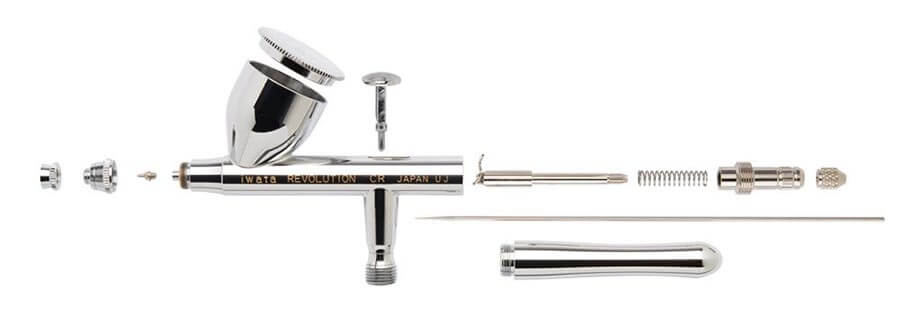
A gravity feed airbrush works by allowing gravity to pull the paint down into the airbrush from a paint cup located on top of the airbrush body.
Once in the airbrush gravity continues to assist by pulling the paint into the atomisation chamber where it is introduced into the high pressure air flow and it atomised.
What Is Airbrush Atomisation?
Atomisation is the process by which the paint is separated into fine particles when introduced into the high pressure air passing through an airbrush, with the atomised paint, which is essentially a mist, then blown by the high pressure air out the front of the airbrush in a perfect spray pattern and onto your job.
A gravity feed airbrush is what is known as an internal mix airbrush, as opposed to, of course, an external mix airbrush.
Internal mix refers to where the paint is mixed with the high pressure airflow and with a gravity feed airbrush this is inside airbrush body in what is called an atomisation chamber.
An external mix airbrush is one that introduces the paint into the airflow outside of the airbrush body and is very common on siphon feed airbrushes that have a paint cup hanging below the airbrush, and rely on the high pressure air to essentially suck the paint out of the cup underneath.
This is the reason the gravity feed airbrush can operate perfectly at lower pressure settings, in that it does not require the additional pressure to suck the air up from the paint cup hanging below.
Speaking of paint cups, the gravity feed airbrush does have some options, which in some cases may be limiting, so it pays to give it some careful consideration before any investment…
Gravity Feed Cup Options
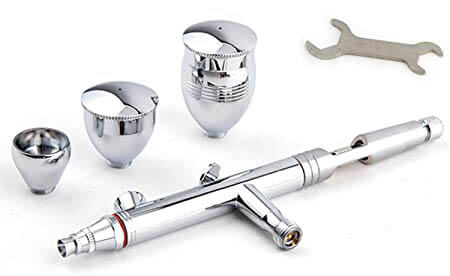
Gravity Feed Cup Sizes
Gravity feed cups range from very small to medium sized, but will not typically reach the larger sizes that siphon feed airbrushes can handle, and we’ll discuss the differences between gravity feed and siphon feed airbrushes in more detail shortly.
If, like me, you’re using your airbrush as part of scale model building, then the very small paint cups on a gravity feed style airbrush will be way too small and not practical.
However the medium sized cups, as shown below on the Iwata Revolution CR airbrush, is more than adequate and will hold enough paint for the larger jobs you’ll have in model construction.
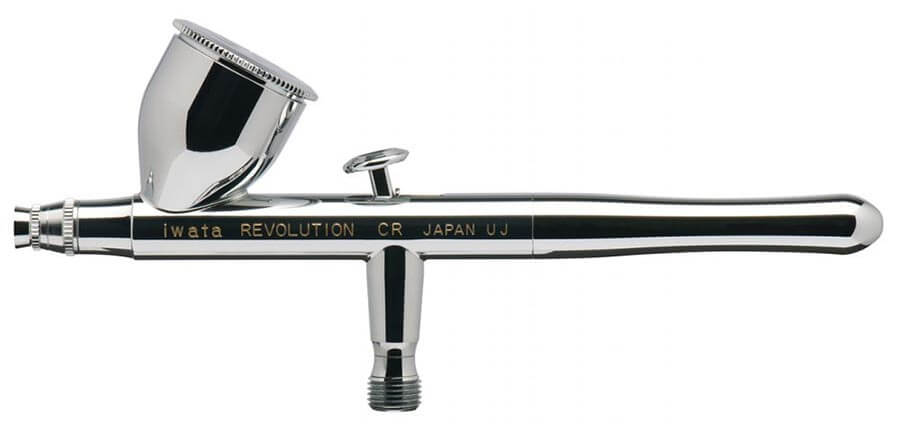
I know this to be true as it’s the type of airbrush I’ve personally used for the last fifteen years and it’s never let me down. 👍
Gravity Feed Cup Lids
Usually a gravity feed airbrush will come with a paint cup lid, which isn’t often required unless you have the paint cup quite full.
Personally I wouldn’t airbrush without one though as sometimes I’ve held the airbrush in unusual positions while painting and without the lid on the paint would have spilt out causing a terrible mess.
Swappable Gravity Feed Paint Cups
Most gravity feed airbrushes will have the paint cup manufactured directly into airbrush body as one contiguous unit, however, while not common at all, some manufacturers will allow you to swap the paint cups on a gravity feed airbrush.
However, if you simply get an airbrush that’s big enough for your needs right off the bat, then there’s little benefit to swapping paint cups in the long run.
But each to their own…
Pro’s And Cons Of A Gravity Feed Airbrush
Compared to other types of airbrushes (discussed below in more detail) the gravity feed airbrush has a number of advantages and disadvantages which need to be considered if you’re in the market for a new airbrush.
Advantages Of A Gravity Feed Airbrush
| Lower Pressure Requirements | Because gravity assists in getting the paint into the airflow is requires less pressure to operate properly. |
| Fine Detail Capabilities | Because a gravity feed airbrush requires less pressure on average for perfect operation, close up fine detail work is possible. |
| Less Paint Wastage | All of the paint in a top mounted paint cup can be used as it filters out of the bottom of the cup, the same is not true of a low hanging paint cup that has to suck the paint up. |
| Less Overspray | The lower pressure required (on average) of a gravity feed airbrush means less paint wastage from overspray, i.e. too much paint being shot at the part and essentially missing. |
Disadvantages Of A Gravity Feed Airbrush
| Potential Messiness | The occasional gravity feed airbrush will not ship with a lid for the cup, which can lead to spills if the cup is quite full. Usually you’ll get a lid though. |
| Slower Colour Changes | The paint cup on a gravity feed airbrush cannot usually be swapped, so every colour change means an airbrush clean. In practise this isn’t as onerous as it sounds though. |
| Paint Volume Requirements | If you require a LOT of paint for a specific job the gravity feed paint cup can be limiting. |
For more details on specific models of popular gravity feed airbrushes see the table below where you can get full user reviews and current prices:
| Airbrush Brand/Model | Link To Reviews | |
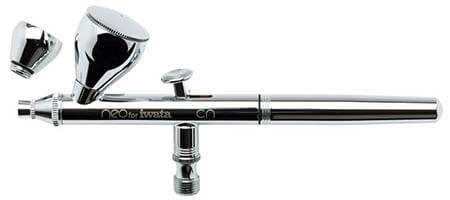 | Iwata Neo CN Airbrush | Click Here For Reviews & Current Prices |
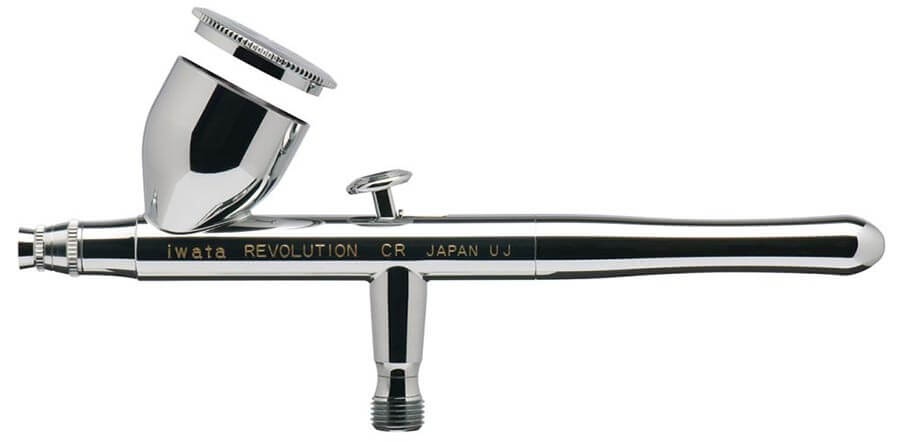 | Iwata Revolution CR Airbrush | Click Here For Reviews & Current Prices |
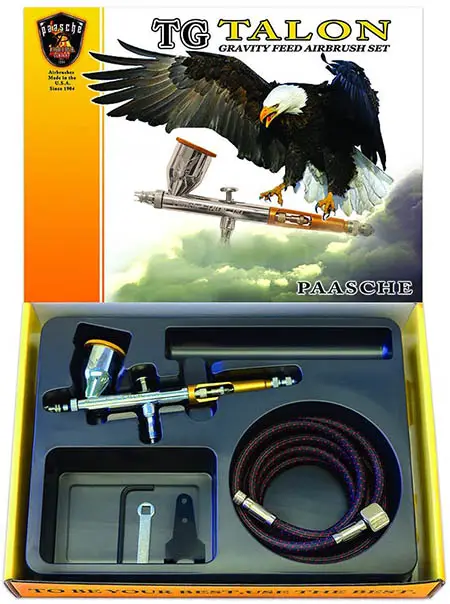 | Paasche TG-Set Airbrush | Click Here For Reviews & Current Prices |
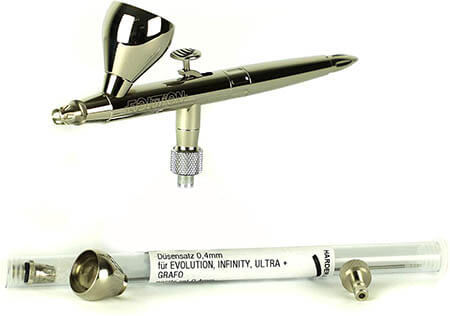 | Harder & Steenbeck Evolution Silverline Two-In-One Airbrush | Click Here For Reviews & Current Prices |
So now you’ve seen the pro’s and cons of a gravity feed airbrush and also had time to review specific models, but what other types of airbrush are there and how does the gravity feed airbrush stack up against them?
What Types Of Airbrushes Are There Besides Gravity Feed
There are three distinct types of airbrush, being the gravity feed, siphon feed, and side feed airbrushes.
Siphon Feed Airbrush
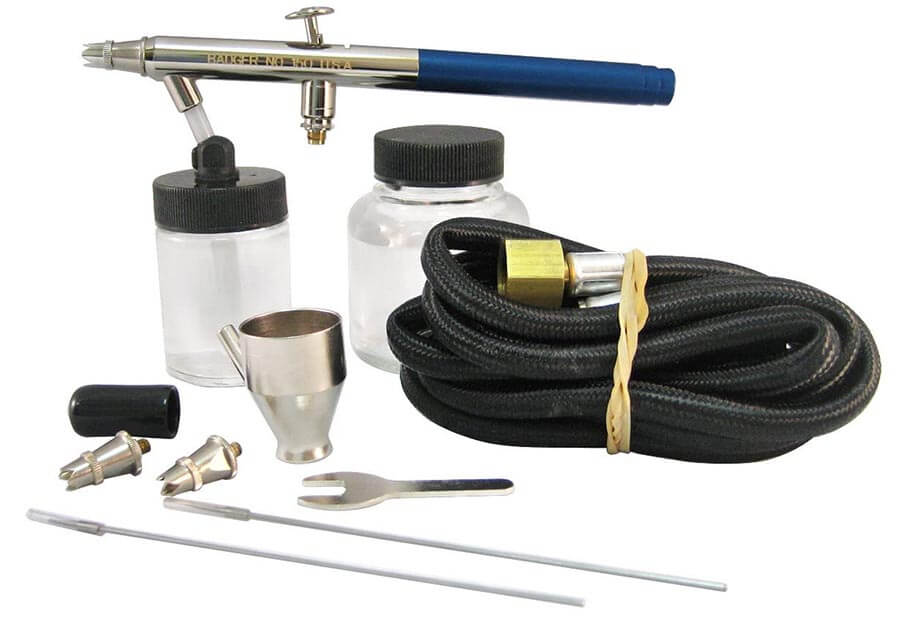
A siphon feed airbrush, as touched on earlier, holds the paint in a jar underneath the airbrush body and uses the pressure of the compressed air passing through the airbrush to draw the paint up from the paint cup via a paint tube.
From here it is introduced into the airflow to atomise and be sprayed onto your work.
On average, higher pressures are required when using a siphon feed airbrush
Below are a couple of examples of siphon feed airbrush including reviews and links to current prices. 👍
| Airbrush Brand/Model | Link To Reviews | |
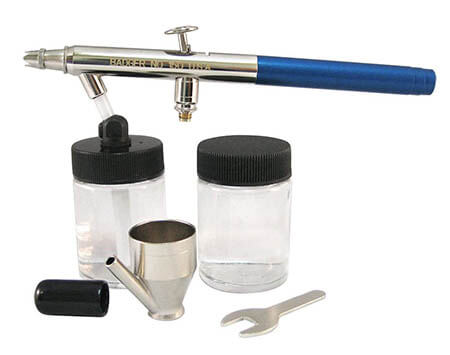 | Badger 150 Airbrush | Click Here For Reviews & Current Prices |
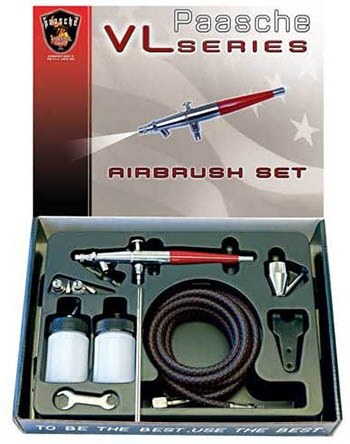 | Paasche VL Double Action Siphon Feed Airbrush Set | Click Here For Reviews & Current Prices |
Side Feed Airbrush
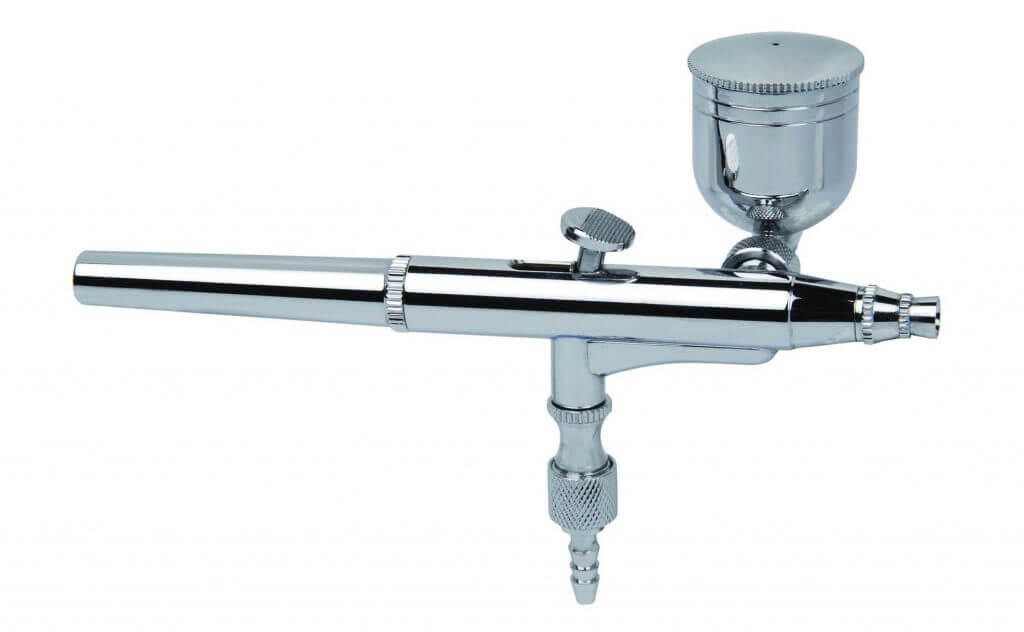
A side feed airbrush is one that has the paint cup position directly to the side of the airbrush body, and could be considered both a siphon feed and gravity feed airbrush depending on how you use it.
👍 For more information on side feed airbrushes and their unique characteristics click this link for a detailed article on this airbrush type.
You won’t find too many side feed airbrushes on the market, for whatever reason they’re not overly popular despite having some advantages, they seem to be over-shadowed by their gravity feed and siphon feed counterparts that form the bulk of the airbrush options.
Before we move on however, if a side feed airbrush does interest you, you can see a couple of examples of them below complete with links to reviews and current prices. 👍
| Airbrush Brand/Model | Link To Reviews | |
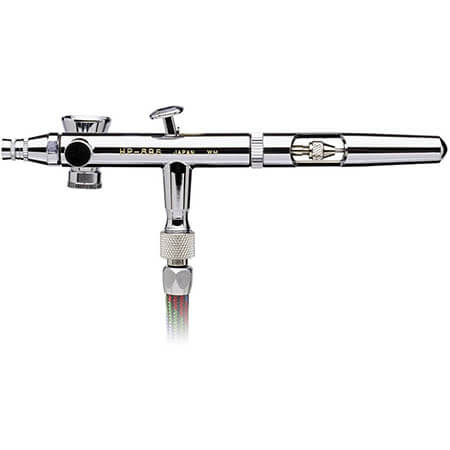 | Iwata Eclipse HP-SBS Side-Feed Dual-Action Airbrush | Click Here For Reviews & Current Prices |
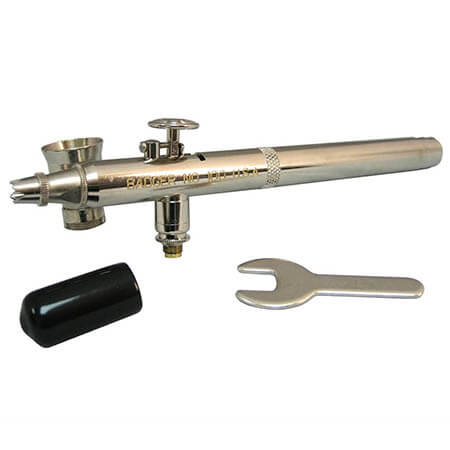 | Badger Model 100 Side-Feed | Click Here For Reviews & Current Prices |
What Is Better Siphon Feed Or Gravity Feed Airbrush
When trying to determine whether gravity feed or siphon feed is better for your creative needs it comes down to more than one factor, as you no doubt guessed from the advantages and disadvantages listed above for gravity feed airbrushes.
However, practically speaking, there will be one or two factors that draw you towards one or the other more strongly.
Ultimately the paint work quality is very comparable between the two types within a similar budget range, but there are a number of other factors to consider.
👍 For an extensive article comparing gravity feed with siphon feed airbrush features check out this detailed article I wrote.
In the meantime though, you’ll find a table of these factors below outlining where each airbrush type has its strengths and weaknesses…
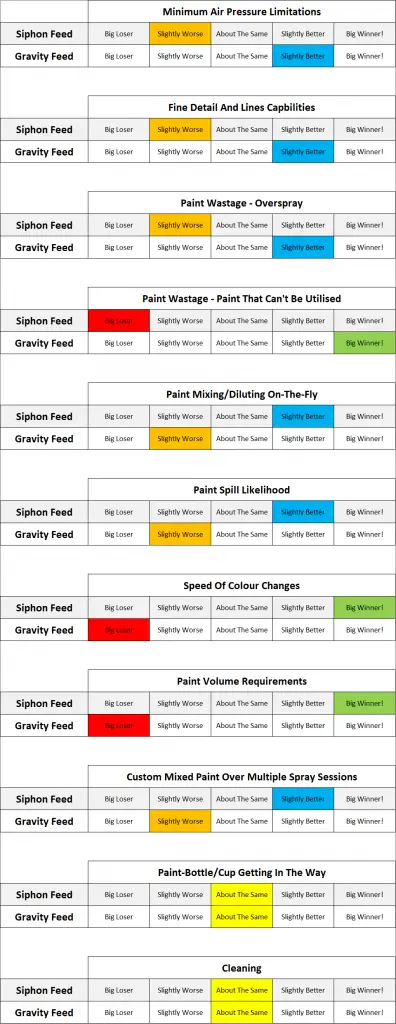
Is A Gravity Feed Airbrush The Best Type Overall
This is quite a personal choice, partly due to the features that you require or value the most, and also what you’re generally drawn to or have experience with.
What I mean by that is that some people simply prefer one over the other for intangible reasons that aren’t objective.
For me personaly, it’s gravity feed all the way.
The reasons are that I prefer the simplicity of a moulded in paint cup, the lower pressure requirements, and the ability to do slightly finer detail work when required.
